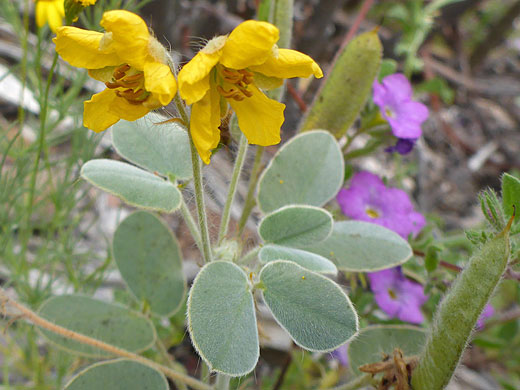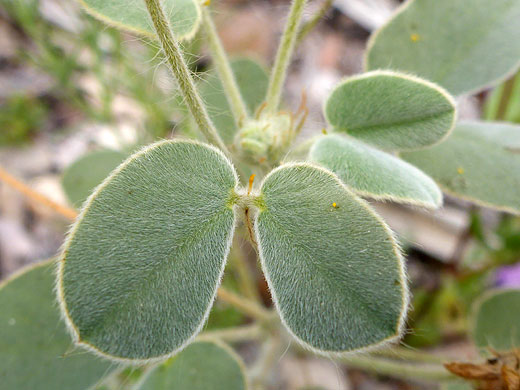
Flowers, leaves and seed pods - senna durangensis along the Dome Trail, Big Bend Ranch State Park, Texas
Common names:
Durango wild sensitive-plant, two-leaved senna
Family:
Scientific name:
Senna durangensis
Main flower color:
Range:
Texas - west (Big Bend area) and in the far south
Height:
Between 8 and 20 inches
Habitat:
Sandy locations in deserts
Leaves:
Divided into a pair of oblong or nearly round leaflets, densely soft-hairy, up to 2 inches long
Season:
March to August
Stems of senna durangensis are ascending to erect, and densely covered with long, soft hairs, white or yellowish. Plants produce several stems, bearing relatively large leaves at alternate intervals; spirally arranged. Leaves are compound; divided into a pair of rounded leaflets, both sides of which are covered by soft, light grey hairs. Leaflet tips, while generally rounded, have a slight point. Leaflets grow on stalks, generally a little longer, up to 3 inches. At the base of the leaflets is a small, brown, protruding gland.
Flowers are produced singly or in clusters of up to six, on hairy stalks rising above the leaves. Flowers have five hairy sepals, a third of an inch in length, and five yellow petals about twice as long. Petals are crossed by darker veins, most noticeable on the undersurface, and more prominent when dry. Anthers are brownish-yellow, and relatively long; nearly the same length as the filaments. Seed pods are hairy, angled upwards, and terminate in a spike.
Flowers are produced singly or in clusters of up to six, on hairy stalks rising above the leaves. Flowers have five hairy sepals, a third of an inch in length, and five yellow petals about twice as long. Petals are crossed by darker veins, most noticeable on the undersurface, and more prominent when dry. Anthers are brownish-yellow, and relatively long; nearly the same length as the filaments. Seed pods are hairy, angled upwards, and terminate in a spike.
All Contents © Copyright The American Southwest | Comments and Questions | Contribute | Site Map


